The AMD Radeon R9 290X Review
by Ryan Smith on October 24, 2013 12:01 AM EST- Posted in
- GPUs
- AMD
- Radeon
- Hawaii
- Radeon 200
XDMA: Improving Crossfire
Over the past year or so a lot of noise has been made over AMD’s Crossfire scaling capabilities, and for good reason. With the evolution of frame capture tools such as FCAT it finally became possible to easily and objectively measure frame delivery patterns. The results of course weren’t pretty for AMD, showcasing that Crossfire may have been generating plenty of frames, but in most cases it was doing a very poor job of delivering them.
AMD for their part doubled down on the situation and began rolling out improvements in a plan that would see Crossfire improved in multiple phases. Phase 1, deployed in August, saw a revised Crossfire frame pacing scheme implemented for single monitor resolutions (2560x1600 and below) which generally resolved AMD’s frame pacing in those scenarios. Phase 2, which is scheduled for next month, will address multi-monitor and high resolution scaling, which faces a different set of problems and requires a different set of fixes than what went into phase 1.
The fact that there’s even a phase 2 brings us to our next topic of discussion, which is a new hardware DMA engine in GCN 1.1 parts called XDMA. Being first utilized on Hawaii, XDMA is the final solution to AMD’s frame pacing woes, and in doing so it is redefining how Crossfire is implemented on 290X and future cards. Specifically, AMD is forgoing the Crossfire Bridge Interconnect (CFBI) entirely and moving all inter-GPU communication over the PCIe bus, with XDMA being the hardware engine that makes this both practical and efficient.
But before we get too far ahead of ourselves, it would be best to put the current Crossfire situation in context before discussing how XDMA deviates from it.

In AMD’s current CFBI implementation, which itself dates back to the X1900 generation, a CFBI link directly connects two GPUs and has 900MB/sec of bandwidth. In this setup the purpose of the CFBI link is to transfer completed frames to the master GPU for display purposes, and to so in a direct GPU-to-GPU manner to complete the job as quickly and efficiently as possible.
For single monitor configurations and today’s common resolutions the CFBI excels at its task. AMD’s software frame pacing algorithms aside, the CFBI has enough bandwidth to pass around complete 2560x1600 frames at over 60Hz, allowing the CFBI to handle the scenarios laid out in AMD’s phase 1 frame pacing fix.
The issue with the CFBI is that while it’s an efficient GPU-to-GPU link, it hasn’t been updated to keep up with the greater bandwidth demands generated by Eyefinity, and more recently 4K monitors. For a 3x1080p setup frames are now just shy of 20MB/each, and for a 4K setup frames are larger still at almost 24MB/each. With frames this large CFBI doesn’t have enough bandwidth to transfer them at high framerates – realistically you’d top out at 30Hz or so for 4K – requiring that AMD go over the PCIe bus for their existing cards.
Going over the PCIe bus is not in and of itself inherently a problem, but pre-GCN 1.1 hardware lacks any specialized hardware to help with the task. Without an efficient way to move frames, and specifically a way to DMA transfer frames directly between the cards without involving CPU time, AMD has to resort to much uglier methods of moving frames between the cards, which are in part responsible for the poor frame pacing we see today on Eyefinity/4K setups.
CFBI Crossfire At 4K: Still Dropping Frames
For GCN 1.1 and Hawaii in particular, AMD has chosen to solve this problem by continuing to use the PCIe bus, but by doing so with hardware dedicated to the task. Dubbed the XDMA engine, the purpose of this hardware is to allow CPU-free DMA based frame transfers between the GPUs, thereby allowing AMD to transfer frames over the PCIe bus without the ugliness and performance costs of doing so on pre-GCN 1.1 cards.
With that in mind, the specific role of the XDMA engine is relatively simple. Located within the display controller block (the final destination for all completed frames) the XDMA engine allows the display controllers within each Hawaii GPU to directly talk to each other and their associated memory ranges, bypassing the CPU and large chunks of the GPU entirely. Within that context the purpose of the XDMA engine is to be a dedicated DMA engine for the display controllers and nothing more. Frame transfers and frame presentations are still directed by the display controllers as before – which in turn are directed by the algorithms loaded up by AMD’s drivers – so the XDMA engine is not strictly speaking a standalone device, nor is it a hardware frame pacing device (which is something of a misnomer anyhow). Meanwhile this setup also allows AMD to implement their existing Crossfire frame pacing algorithms on the new hardware rather than starting from scratch, and of course to continue iterating on those algorithms as time goes on.
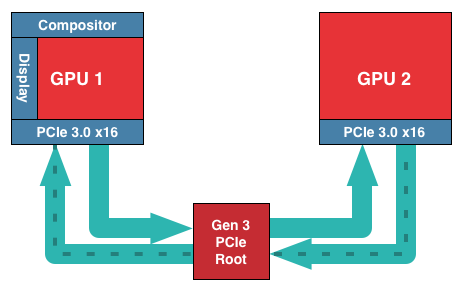
Of course by relying solely on the PCIe bus to transfer frames there are tradeoffs to be made, both for the better and for the worse. The benefits are of course the vast increase in memory bandwidth (PCIe 3.0 x16 has 16GB/sec available versus .9GB/sec for CFBI) not to mention allowing Crossfire to be implemented without those pesky Crossfire bridges. The downside to relying on the PCIe bus is that it’s not a dedicated, point-to-point connection between GPUs, and for that reason there will bandwidth contention, and the latency for using the PCIe bus will be higher than the CFBI. How much worse depends on the configuration; PCIe bridge chips for example can both improve and worsen latency depending on where in the chain the bridges and the GPUs are located, not to mention the generation and width of the PCIe link. But, as AMD tells us, any latency can be overcome by measuring it and thereby planning frame transfers around it to take the impact of latency into account.
Ultimately AMD’s goal with the XDMA engine is to make PCIe based Crossfire just as efficient, performant, and compatible as CFBI based Crossfire, and despite the initial concerns we had over the use of the PCIe bus, based on our test results AMD appears to have delivered on their promises.
The XDMA engine alone can’t eliminate the variation in frame times, but in its first implementation it’s already as good as CFBI in single monitor setups, and being free of the Eyefinity/4K frame pacing issues that still plague CFBI, is nothing short of a massive improvement over CFBI in those scenarios. True to their promises, AMD has delivered a PCie based Crossfire implementation that incurs no performance penalty versus CFBI, and on the whole fully and sufficiently resolves AMD’s outstanding frame pacing issues. The downside of course is that XDMA won’t help the 280X or other pre-GCN 1.1 cards, but at the very least going forward AMD finally has demonstrated that they have frame pacing fully under control.
On a side note, looking at our results it’s interesting to see that despite the general reuse of frame pacing algorithms, the XDMA Crossfire implementation doesn’t exhibit any of the distinct frame time plateaus that the CFBI implementation does. The plateaus were more an interesting artifact than a problem, but it does mean that AMD’s XDMA Crossfire implementation is much more “organic” like NVIDIA’s, rather than strictly enforcing a minimum frame time as appeared to be the case with CFBI.


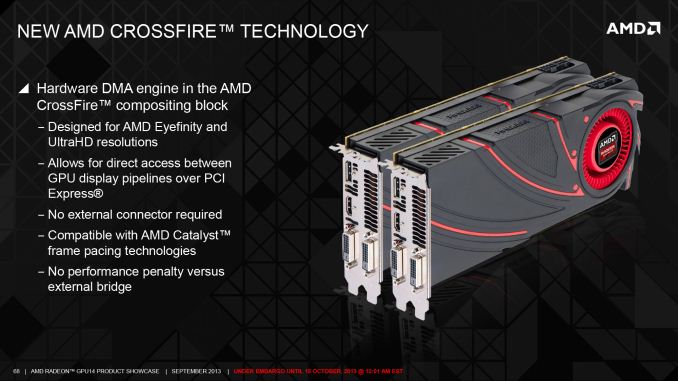
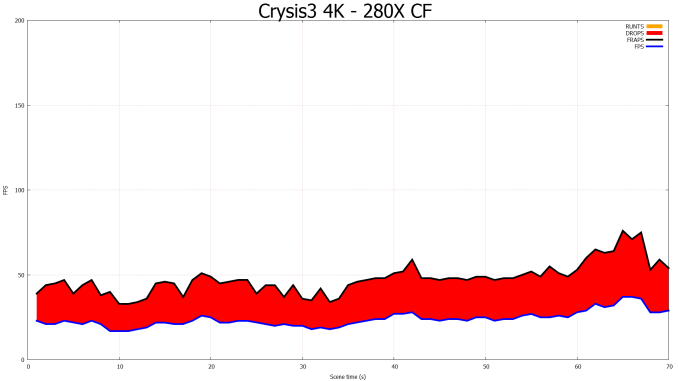
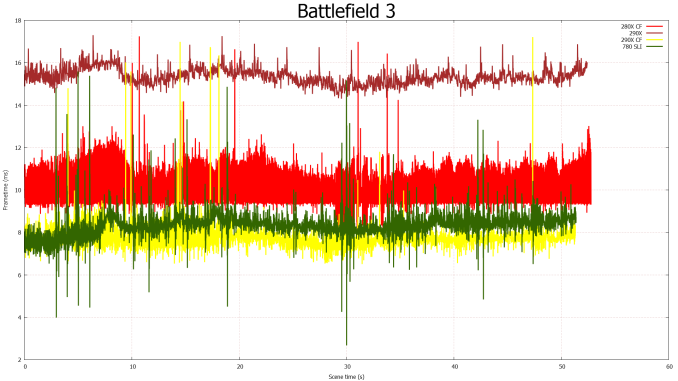
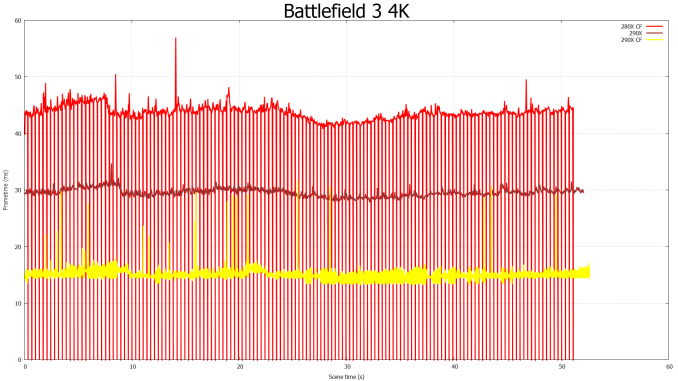








396 Comments
View All Comments
TheJian - Friday, October 25, 2013 - link
Incorrect. Part of the point of gsync is when you can do 200fps in a particular part of the game they can crank up detail and USE the power you have completely rather than making the whole game for say 60fps etc. Then when all kinds of crap is happening on screen (50 guys shooting each other etc) they can drop the graphics detail down some to keep things smooth. Gsync isn't JUST frame rate. You apparently didn't read the anandtech live blog eh? You get your cake and can eat it too (stutter free, no tearing, smooth and extra power used when you have it available).MADDER1 - Friday, October 25, 2013 - link
If Gsync drops the detail to maintain fps like you said, then you're really not getting the detail you thought you set. How is that having your cake and eating it too?Cellar Door - Friday, October 25, 2013 - link
How so? If Mantle gets 760gtx performance in BF4 from a 260X ..will you switch then?Animalosity - Sunday, October 27, 2013 - link
No. You are sadly mistaken sir.Antiflash - Thursday, October 24, 2013 - link
I've usually prefer Nvidia Cards, but they have it well deserved when decided to price GK110 to the stratosphere just "because they can" and had no competition. That's poor way to treat your customers and taking advantage of fanboys. Full implementation of Tesla and Fermi were always priced around $500. Pricing Keppler GK110 at $650+ was stupid. It's silicon after all, you should get more performance for the same price each year. Not more performance at a premium price as Nvidia tried to do this generation. AMD is not doing anything extraordinary here they are just not following nvidia price gouging practices and $550 is their GPU at historical market prices for their flagship GPU. We would not have been having this discussion if Nvidia had done the same with GK110.inighthawki - Thursday, October 24, 2013 - link
" It's silicon after all, you should get more performance for the same price each year"So R&D costs come from where, exactly? Not sure why people always forget that there is actual R&D that goes into these types of products, it's not just some $5 just of plastic and silicon + some labor and manufacturing costs. Like when they break down phones and tablets and calculate costs they never account for this. As if their engineers are basically just selecting components on newegg and plugging them together.
jecastejon - Thursday, October 24, 2013 - link
R&D. Is R&D tied only to a specific Nvidia card? AMD as others also invest a lot in R&D with every product generation, even if they are not successful. Nvidia will have to do a reality cheek with their pricing and be loyal to their fans and the market. Today's advantages don't last for to long.Antiflash - Thursday, October 24, 2013 - link
NVIDIA's logic. Kepler refresh: 30% more performance => 100% increase in priceAMD's logic. GCN refresh: is 30% more preformance => 0% increase in price
I can't see how this is justified by R&D of just a greedy company squishing its more loyal customer base.
Antiflash - Thursday, October 24, 2013 - link
Just for clarification. price comparison between cards at its introduction comparing NVIDIA's 680 vs Titan and AMD's 7970 vs 290xTheJian - Friday, October 25, 2013 - link
AMD way=ZERO PROFITS company going broke, debt high, 6Bil losses in 10yrsNV way=500-800mil profits per year so you can keep your drivers working.
Your love of AMD's pricing is dumb. They are broke. They have sold nearly everything they have or had, fabs, land, all that is left is the company itself and IP.
AMD should have priced this card at $650 period. Also note, NV hasn't made as much money as 2007 for 6 years. They are not gouging you or they would make MORE than before in 2007 right? Intel, Apple, MS are gouging you as they all make more now than then (2007 was pretty much highs for a lot of companies, down since). People like you make me want to vomit as you just are KILLING AMD, which in turn will eventually cost me dearly buying NV cards as they will be the only ones with real power in the next few years. AMD already gave up the cpu race. How much longer you think they can fund the gpu race with no profits? 200mil owed to GF in Dec 31, so the meager profit they made last Q and any they might have made next Q is GONE. They won't make 200mil profit next Q...LOL. Thanks to people like you asking for LOW pricing and free games.
You don't even understand you are ANTI-AMD...LOL. Your crap logic is killing them (and making NV get 300mil less profit than 2007). The war is hurting them both. I'd rather have AMD making 500mil and NV making 1B than what we get now AMD at ZERO and NV at 550mil.